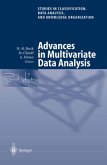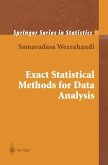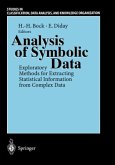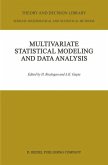Geometric Data Analysis (GDA) is the name suggested by P. Suppes (Stanford University) to designate the approach to Multivariate Statistics initiated by Benzécri as Correspondence Analysis, an approach that has become more and more used and appreciated over the years. This book presents the full formalization of GDA in terms of linear algebra - the most original and far-reaching consequential feature of the approach - and shows also how to integrate the standard statistical tools such as Analysis of Variance, including Bayesian methods. Chapter 9, Research Case Studies, is nearly a book in itself; it presents the methodology in action on three extensive applications, one for medicine, one from political science, and one from education (data borrowed from the Stanford computer-based Educational Program for Gifted Youth ). Thus the readership of the book concerns both mathematicians interested in the applications of mathematics, and researchers willing to master an exceptionally powerful approach of statistical data analysis.
From the reviews:
"Simply a masterpiece (...) I find this book to be a treasure chest"- Johs Hjellbrekke in the European Sociological Rev.2005; 21: 529-531
"Written in a mathematically rigorous way at a very high scientific level, the book represents an outstanding monograph in the field of multivariate statistics. The book provides a comprehensive presentation of the essentials in approaching multivariational data analysis in geometric terms. The illustrative examples and the exercises ... are welcome and facilitate substantially the understanding of the contents. ... the book proves extremely helpful and informative to a large class of readers, academics, postgraduate students and practitioners from a variety of disciplines." (Luminita State, Zentralblatt MATH, Vol. 1095 (22), 2006)
"The book under review meets the following two requirements: first, it presents in full the formalization of GDA in terms of the structures of linear algebra ... and second, it shows how conventional statistical methods are applicable to structured data analysis ... . The book is accessible to a wide audience of practising scientists. The mathematical framework is carefully explained. It is an important and much needed contribution to the statistical use of geometric ideas in the description and analysis of scientific data." (Wojciech Zielinski, Mathematical Reviews, Issue 2006 e)
"The uniqueness of this work lies in the detailed conceptual framework, and in showing how, where and why statistical inference methods come into play. ... In conclusion, this book constitutes essential background material on Geometric Data Analysis, and, for the seasoned professional, a most valuable source of reference." (Fionn Murtagh, Journal of Classification, Vol. 25, 2008)
"Simply a masterpiece (...) I find this book to be a treasure chest"- Johs Hjellbrekke in the European Sociological Rev.2005; 21: 529-531
"Written in a mathematically rigorous way at a very high scientific level, the book represents an outstanding monograph in the field of multivariate statistics. The book provides a comprehensive presentation of the essentials in approaching multivariational data analysis in geometric terms. The illustrative examples and the exercises ... are welcome and facilitate substantially the understanding of the contents. ... the book proves extremely helpful and informative to a large class of readers, academics, postgraduate students and practitioners from a variety of disciplines." (Luminita State, Zentralblatt MATH, Vol. 1095 (22), 2006)
"The book under review meets the following two requirements: first, it presents in full the formalization of GDA in terms of the structures of linear algebra ... and second, it shows how conventional statistical methods are applicable to structured data analysis ... . The book is accessible to a wide audience of practising scientists. The mathematical framework is carefully explained. It is an important and much needed contribution to the statistical use of geometric ideas in the description and analysis of scientific data." (Wojciech Zielinski, Mathematical Reviews, Issue 2006 e)
"The uniqueness of this work lies in the detailed conceptual framework, and in showing how, where and why statistical inference methods come into play. ... In conclusion, this book constitutes essential background material on Geometric Data Analysis, and, for the seasoned professional, a most valuable source of reference." (Fionn Murtagh, Journal of Classification, Vol. 25, 2008)









